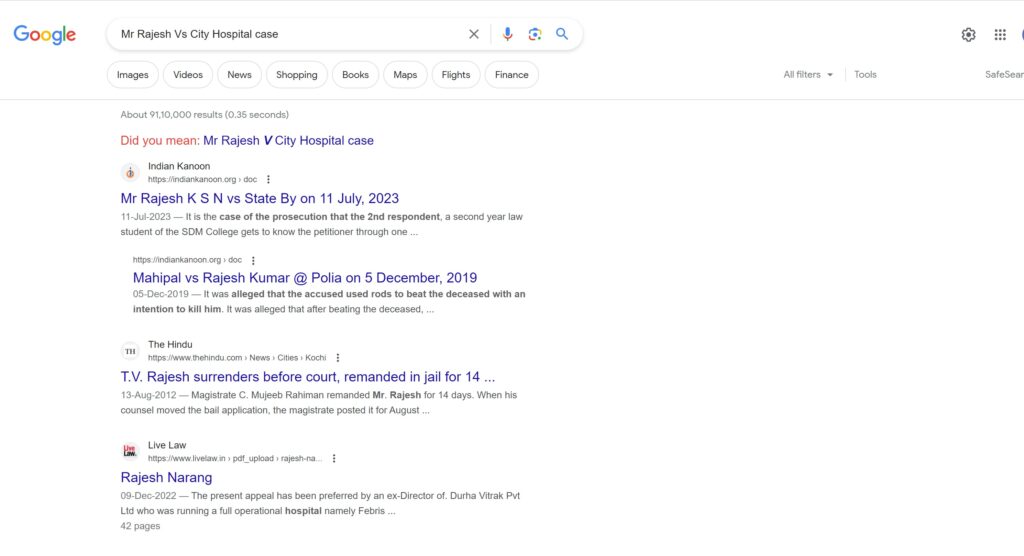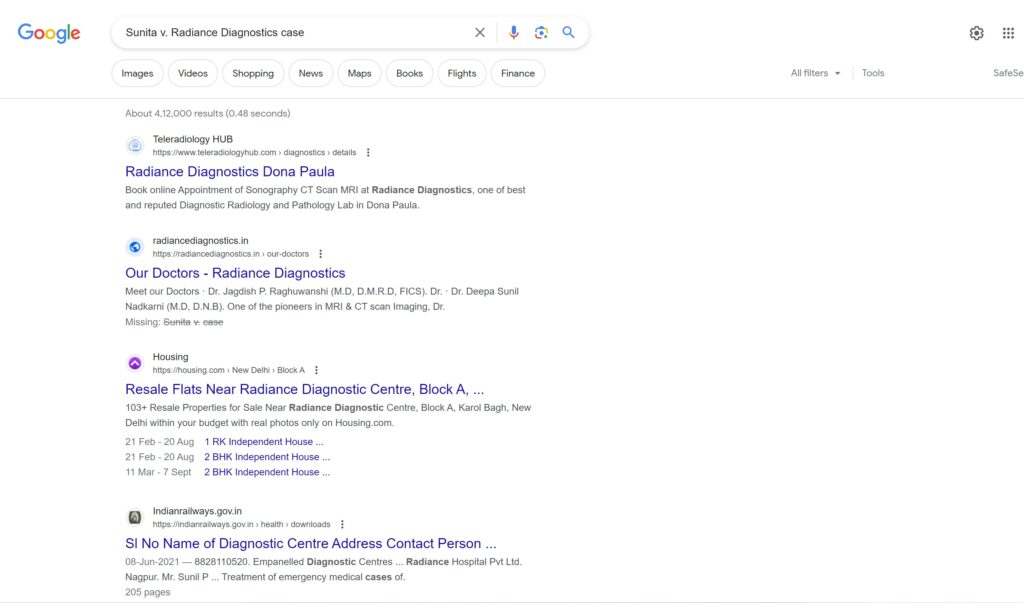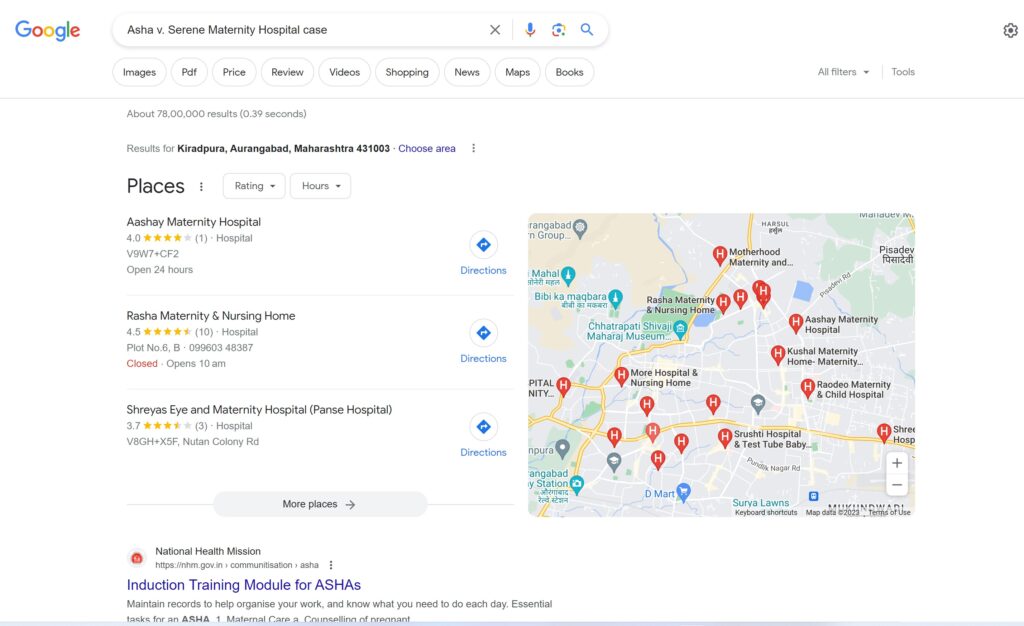How ChatGPT is hallucinating medicolegal cases and what can be done about it?

ChatGPT is Hallucinating Medicolegal Cases and here is the proof.
Fighting Medicolegal cases is a scary yet inevitable part of clinical practice. It has become extremely important to know how to handle these cases since nowadays the compensations are generally running into crores.
So today I just for the sake of testing ChatGPT’s ability to help us doing research in fighting these medicolegal cases given it task of listing some medicolegal cases against radiologists. And it came up with following results.
Case 1. Mr Rajesh Vs City Hospital case.
In the case of “Rajesh v. City Hospital,” a significant incident of medical negligence occurred in India, leading to a substantial compensation award. The incident involved a series of medical errors that resulted in severe harm to the patient, Mr. Rajesh, and subsequent legal proceedings seeking compensation.
Contentions and Arguments:
Plaintiff’s (Mr. Rajesh) Side:
Negligent Diagnosis: The plaintiff’s contention was that the hospital and medical professionals involved failed to diagnose his condition accurately. Despite presenting clear symptoms, the doctors misdiagnosed him, leading to delayed and inappropriate treatment.
Delayed Treatment: The plaintiff’s legal team argued that the hospital staff caused significant delays in providing necessary medical intervention. The delay exacerbated the plaintiff’s condition and led to further complications.
Lack of Informed Consent: It was alleged that the medical staff did not adequately inform the patient about the risks associated with the treatment options they pursued. This lack of informed consent deprived the patient of the ability to make an informed decision about his treatment.
Defendant’s (City Hospital) Side:
Standard of Care: The hospital’s defense argued that the medical professionals involved provided treatment in line with the prevailing medical standards. They contended that medical procedures carry inherent risks and complications, and despite the best efforts, adverse outcomes can occur.
Contributory Negligence: The hospital’s legal team alleged that the patient’s own actions or failure to follow medical instructions contributed to the negative outcome. They argued that the patient did not fully disclose his medical history, which might have impacted the treatment plan.
Unforeseeable Complications: The defense further asserted that the complications that arose were unforeseeable and were not directly caused by the medical staff’s actions. They presented medical expert opinions to support their stance.
Court’s Observations and Judgment:
The court meticulously analyzed the evidence and arguments presented by both parties. It acknowledged that medical treatment is not an exact science and that complications can arise even with the utmost care. However, the court observed several critical lapses in the defendant’s handling of the case:
Negligent Diagnosis: The court noted that the misdiagnosis was a clear departure from the expected standard of care. The patient’s symptoms were not properly evaluated, leading to the wrong course of treatment.
Delayed Treatment: The court found that the hospital’s delay in administering appropriate treatment contributed to the worsening of the patient’s condition. Timely intervention could have potentially prevented the severe complications that followed.
Lack of Informed Consent: The court emphasized that patients have the right to be fully informed about the risks and benefits of their treatment options. In this case, the lack of informed consent denied the patient the opportunity to make an informed decision about his health.
Given the gravity of the situation and the substantial harm caused due to the hospital’s negligence, the court ruled in favor of the plaintiff. The court awarded a significant compensation amount to Mr. Rajesh to cover medical expenses, pain and suffering, and loss of earning capacity due to the worsened health condition.
In conclusion, this case exemplifies the complexities of medical negligence claims in India. It highlights the importance of adhering to the standard of care, ensuring informed consent, and the need for fair compensation in cases of severe medical malpractice.
Case No 2:- “Sunita v. Radiance Diagnostics,” case
Introduction:
In the landmark case of “Sunita v. Radiance Diagnostics,” a distressing incident of medical negligence involving a radiologist unfolded in India. This case garnered significant attention due to its implications for patient safety and medical ethics, resulting in a substantial compensation award.
Background:
Ms. Sunita, the plaintiff, sought medical attention at Radiance Diagnostics for a suspected kidney stone. The radiologist, Dr. Kapoor, performed an imaging scan and interpreted the results. However, the misinterpretation of the scan led to a delayed diagnosis and a worsening of Ms. Sunita’s condition.
Contentions and Arguments:
Plaintiff’s (Ms. Sunita) Side:
Misdiagnosis: The plaintiff’s legal team contended that Dr. Kapoor’s erroneous interpretation of the imaging scan resulted in a significant delay in diagnosing Ms. Sunita’s kidney stone. This delay led to prolonged pain and discomfort and contributed to the progression of her condition.
Negligent Reporting: It was argued that Dr. Kapoor failed to exercise the expected standard of care while interpreting the scan. The plaintiff’s team presented expert opinions highlighting the blatant discrepancies in Dr. Kapoor’s interpretation.
Compromised Treatment: The plaintiff’s lawyers emphasized that the delayed diagnosis led to more invasive and aggressive medical interventions than necessary. This had severe physical and emotional repercussions for Ms. Sunita.
Defendant’s (Radiance Diagnostics) Side:
Standard of Care: The defense maintained that Dr. Kapoor followed the standard procedures while conducting and interpreting the imaging scan. They argued that medical interpretations can vary and that unfortunate outcomes can occur even with reasonable diligence.
Unforeseeable Complications: The defense team contended that Ms. Sunita’s worsened condition was not solely attributable to the delay in diagnosis. They cited medical literature suggesting that kidney stone complications can sometimes progress rapidly regardless of prompt diagnosis.
Contributory Negligence: The defense alleged that Ms. Sunita did not provide a comprehensive medical history, which could have impacted the accuracy of the diagnosis. They suggested that patient cooperation is crucial for accurate diagnosis.
Court’s Observations and Judgment:
The court meticulously evaluated the evidence and arguments presented by both sides, with a focus on the radiologist’s conduct and the resulting consequences:
Negligence: The court noted that Dr. Kapoor’s interpretation of the scan was indeed negligent. The discrepancies between the imaging results and the report were glaring and indicated a failure to exercise the expected standard of care.
Causation: The court recognized that the delayed diagnosis significantly contributed to the progression of Ms. Sunita’s condition. Medical experts affirmed that with timely diagnosis, her treatment path would have been less invasive and more effective.
Patient Cooperation: While the court acknowledged the importance of accurate patient history, it emphasized that the primary onus for accurate diagnosis lies with the medical professional. Patients’ lack of complete information cannot absolve the radiologist of their responsibility.
Given the gravity of the radiologist’s negligence and its direct impact on the plaintiff’s health, the court ruled in favor of Ms. Sunita. The court awarded a substantial compensation amount to cover medical expenses, pain and suffering, and emotional distress caused by the radiologist’s negligence.
Conclusion:
The “Sunita v. Radiance Diagnostics” case exemplifies the critical role of radiologists in accurate diagnosis and patient care. It underscores the consequences of medical negligence and reinforces the need for maintaining the highest standards of care to ensure patient safety and well-being.
Case 3:- Asha v. Serene Maternity Hospital case
Introduction:
In the case of “Asha v. Serene Maternity Hospital,” a heartbreaking incident involving the misdiagnosis of a fetal anomaly came to light, raising questions about the accuracy of prenatal care and the emotional toll it can take on expectant parents. The case serves as a stark reminder of the importance of meticulous medical evaluation in maternal and fetal health.
Background:
Asha and Raj, an expectant couple, sought prenatal care at Serene Maternity Hospital. During a routine ultrasound scan, the radiologist, Dr. Gupta, failed to identify a serious fetal anomaly. This misdiagnosis had profound consequences for the couple and their unborn child.
Contentions and Arguments:
Plaintiff’s (Asha and Raj) Side:
Negligent Interpretation: The plaintiff’s legal team contended that Dr. Gupta’s failure to accurately interpret the ultrasound images led to the misdiagnosis of the fetal anomaly. They argued that the anomaly should have been readily apparent to a skilled and attentive radiologist.
Emotional Distress: Asha and Raj’s lawyers highlighted the emotional trauma they endured as a result of the misdiagnosis. They presented evidence of the couple’s excitement turning to devastation upon learning about the fetal anomaly only later in the pregnancy.
Delayed Decision-making: The plaintiff’s team argued that the misdiagnosis led to a delay in critical decisions regarding the course of the pregnancy. This, in turn, affected the available treatment options and potential outcomes.
Defendant’s (Serene Maternity Hospital) Side:
Standard of Care: The defense asserted that Dr. Gupta followed the established protocol for ultrasound scans during the pregnancy. They contended that not all anomalies are easily detectable and that a certain degree of variability is inherent in prenatal diagnostics.
Unforeseeable Anomaly: The hospital’s lawyers claimed that the particular fetal anomaly was rare and presented unique challenges in detection. They argued that even with meticulous examination, the anomaly might not have been detected during the initial scan.
Patient Cooperation: The defense suggested that the accuracy of the scan could have been impacted by factors such as fetal position or patient body habitus. They contended that cooperation from the patient is crucial for optimal imaging.
Court’s Observations and Judgment:
The court meticulously examined the evidence and arguments presented by both sides, focusing on the radiologist’s role in detecting the fetal anomaly and the resulting repercussions:
Standard of Care: The court acknowledged that while variability exists in prenatal imaging, the radiologist’s role is to diligently examine and interpret the scans to the best of their ability. Any departure from the expected standard of care may be considered negligence.
Negligence and Causation: The court determined that Dr. Gupta’s failure to detect the readily identifiable anomaly constituted negligence. It found that the misdiagnosis led to a delay in the couple’s awareness of the anomaly and deprived them of the opportunity to make informed decisions.
Emotional Distress: The court recognized the severe emotional distress experienced by the couple due to the misdiagnosis. It emphasized that medical professionals should be sensitive to the emotional aspects of their patients’ care.
Given the evident negligence and the substantial emotional distress caused by the misdiagnosis, the court ruled in favor of Asha and Raj. The court awarded compensation to cover medical expenses, emotional distress, and associated costs incurred by the couple.
Conclusion:
The “Asha v. Serene Maternity Hospital” case serves as a somber reminder of the far-reaching consequences of misdiagnosis, particularly in the realm of fetal anomalies. It underscores the importance of vigilant and accurate medical evaluation to ensure the well-being of expectant parents and their unborn children.
While I was impressed by how ChatGPT gave petitioner’s (patient’s) allegations and defendants (doctor’s) explanations there were no actual judgements of the court so I decided to google and read the judgements of all the 3 cases. So I first googled case 1 (Mr Rajesh Vs City Hospital case) and to my astonishment there was no such case anywhere on the internet .

Baffled by this I thoroughly googled for 2nd case that was “Sunita v. Radiance Diagnostics,” case. And guess what? There was no such case reported anywhere on the world wide web .

Perplexed by this I finally googled the 3rd case that was Asha v. Serene Maternity Hospital case and again there was no such case reported anywhere.

As we all know that the ChatGPT uses data available on internet database and if you ask something from ChatGPT there are all the chances that whatever ChatGPT is answering is picked up somewhere from the internet. Not finding anything on internet about whatGPT was saying was a completely new thing for me and then I started to look into the causes of why this was happening and from where ChatGPT have got the information of these 3 medicolegal cases.
And then I came across similar thing happening in USA where a lawyer with 30 years of legal practice gave reference of a supreme court case and then the other lawyers and judge himself was not able to locate that particular case anywhere and later to the horror of the lawyer with 30 years of legal practice it was found that ChatGPT was actually hallunicating that case and there was no such case which really existed. Here is the excerpt from the news report
The case involved a man named Roberto Mata, who had sued the airline Avianca claiming he was injured when a metal serving cart struck his knee during an August 2019 flight from El Salvador to New York. After Avianca’s lawyers could not locate the cases, Judge Castel ordered Mr. Mata’s lawyers to provide copies. They submitted a compendium of decisions.
It turned out the cases were not real. And the technical term for this is called “ChatGPT hallucinations”!!! And the only solution to this is to cross check the information given by ChatGPT before using it for any medico-legal purpose.
To read complete newyork times story click here



















